
Creating a pond ecosystem
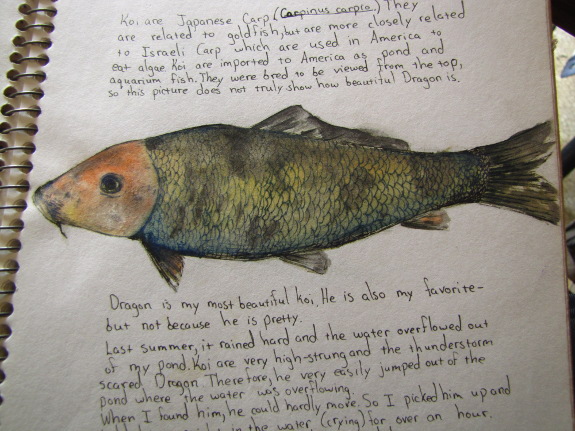
Until I sat down on
Friday afternoon to watch my three tiny
goldfish soar
through their watery environment, I'd forgotten how much joy I used to
get from the three little ponds I built in my city backyard as a
high-school kid. Yes, while normal people were out doing whatever
teenagers do, I was building a resilient pond ecosystem (a success),
trying to get moss to grow on concrete (a failure), and making daily
sketches of whatever caught my eye.
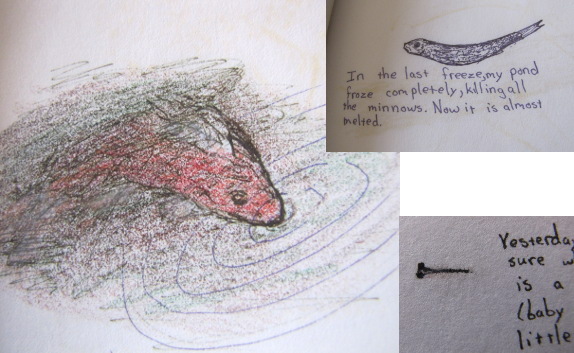
I flipped back through
the sketchbooks this weekend to refresh my memory about what exactly
was in that pond ecosystem. The fish, of course, got top
billing. I tried to add minnows out of a nearby creek, but most
died immediately due to low dissolved oxygen levels in the unmoving
water, and the last ones froze over the winter. Koi were
beautiful, but really too big for my "mud puddles" (as annoyed siblings
were known to call them), and not winter hardy. On the other
hand, I'm pretty sure my feeder goldfish froze solid one winter and
came back to life that spring. They even got big enough to fill
the ponds with tiny goldfish fry!
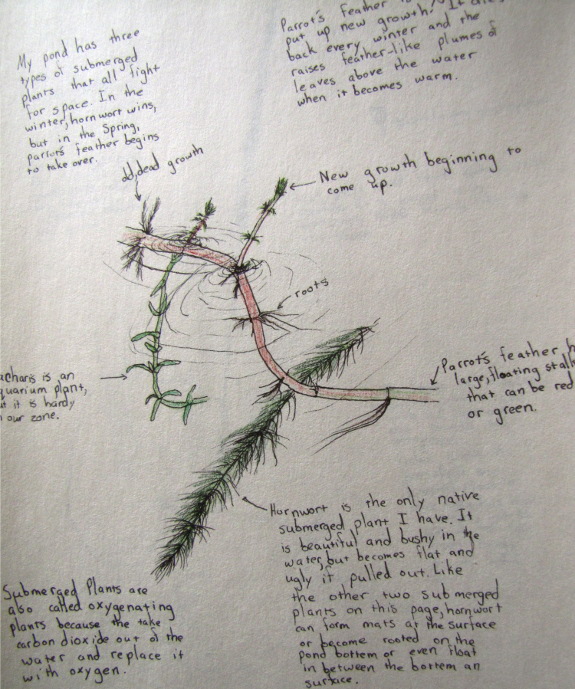
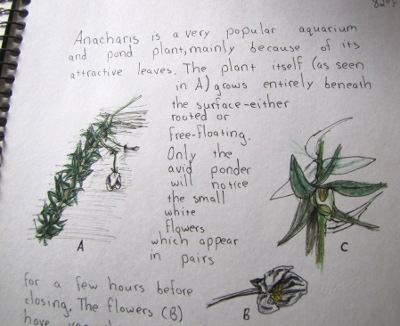 Even though the fish were the
most eye-catching, what I wanted to recall were the details about my
submerged plants. I suspect it was my trio of parrot's feather,
anacharis, and hornwort that kept oxygen levels high enough for the
fish to survive, and also gave them plenty of places to hide.
Hornwort was the most cold hardy and the one I want to add to my
current pondlet, but I didn't make any notes in my sketchbooks about
where the plants came from. (I'm pretty sure the other two
species came from the pet store, so maybe the hornwort did too?)
Even though the fish were the
most eye-catching, what I wanted to recall were the details about my
submerged plants. I suspect it was my trio of parrot's feather,
anacharis, and hornwort that kept oxygen levels high enough for the
fish to survive, and also gave them plenty of places to hide.
Hornwort was the most cold hardy and the one I want to add to my
current pondlet, but I didn't make any notes in my sketchbooks about
where the plants came from. (I'm pretty sure the other two
species came from the pet store, so maybe the hornwort did too?)
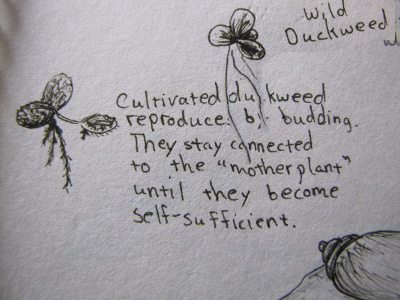 Duckweed was another secret
ingredient to successful pond culture. I included two species,
one of which came from the aquarium store, was fuzzy on top, and died
out eventually. The other was a good, hardy native that is still
present in the remaining pond in my mother's backyard twenty years
later. (Unfortunately, despite internet claims to the contrary,
my chickens think hardy duckweed is for losers. Maybe they would
have liked the cultivated species better?)
Duckweed was another secret
ingredient to successful pond culture. I included two species,
one of which came from the aquarium store, was fuzzy on top, and died
out eventually. The other was a good, hardy native that is still
present in the remaining pond in my mother's backyard twenty years
later. (Unfortunately, despite internet claims to the contrary,
my chickens think hardy duckweed is for losers. Maybe they would
have liked the cultivated species better?)
Of course, there were
more photogenic plants too. I played with just about everything
from lilies to flags to forget-me-nots, and most of them slowly petered
out when the pond froze 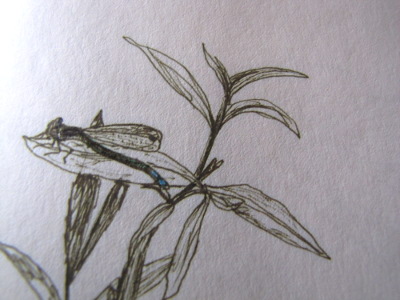 through. Having some
emergent plants was handy, though, because it seemed to attract insect
life --- damselflies, dragonflies, and water striders all showed up and
bred. Frogs arrived too, one of whom actually sat on a lily pad,
to my extreme surprise --- I thought that behavior was only a
characteristic of cartoon animals. I even learned to identify
song sparrows when they came to bathe at the pond on warm afternoons.
through. Having some
emergent plants was handy, though, because it seemed to attract insect
life --- damselflies, dragonflies, and water striders all showed up and
bred. Frogs arrived too, one of whom actually sat on a lily pad,
to my extreme surprise --- I thought that behavior was only a
characteristic of cartoon animals. I even learned to identify
song sparrows when they came to bathe at the pond on warm afternoons.
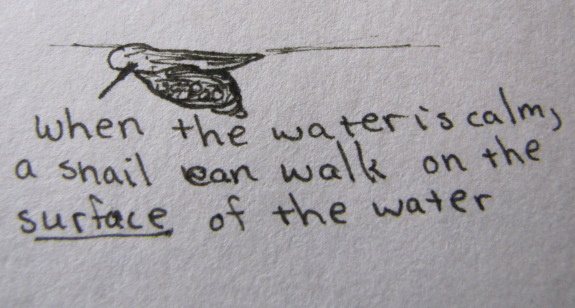
I'm not sure where the
water snails came from, but they were real winners. I identified
them (rightly or wrongly) as tadpole snails, and they laid gelatinous
masses of eggs on the submerged plants, creating a host of mini-snails
who grew like gangbusters. The snails kept things clean, and as I
discovered one still day, could even slide across the underside of the
water surface using water tension, like a water strider in reverse.
(I think these guys have a potential for chicken feed, if we can figure
out how to prepare them properly.)
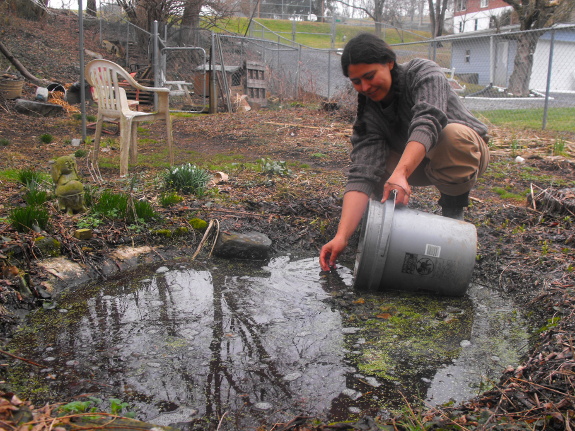
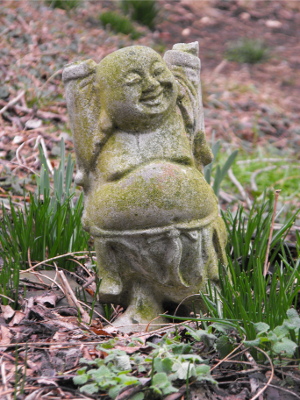 If I had built my guilds
perfectly, you'd think the pond would still contain just as much
diversity 16.5 years after I graduated and left the aquatic ecosystem
to its own devices. Instead, everything seems to have disappeared
except the duckweed (and possibly the tadpole snails). I mostly
blame the decline in biodiversity on the small scale --- it's tough to
keep a fifteen-gallon world in balance.
If I had built my guilds
perfectly, you'd think the pond would still contain just as much
diversity 16.5 years after I graduated and left the aquatic ecosystem
to its own devices. Instead, everything seems to have disappeared
except the duckweed (and possibly the tadpole snails). I mostly
blame the decline in biodiversity on the small scale --- it's tough to
keep a fifteen-gallon world in balance.
On the bright side, I do
seem to have finally managed to grow moss on my laughing Buddha.
Too bad he needs to stand guard over the first generation and can't
move to my new digs. Maybe I'll find a new mascot for my
twenty-first century pondlet?
Want more in-depth information? Browse through our books.
Or explore more posts by date or by subject.
About us: Anna Hess and Mark Hamilton spent over a decade living self-sufficiently in the mountains of Virginia before moving north to start over from scratch in the foothills of Ohio. They've experimented with permaculture, no-till gardening, trailersteading, home-based microbusinesses and much more, writing about their adventures in both blogs and books.
Want to be notified when new comments are posted on this page? Click on the RSS button after you add a comment to subscribe to the comment feed, or simply check the box beside "email replies to me" while writing your comment.

This reminds me of my pond, but I used to call it a water garden. I kept feeder goldfish in it and captured a Southern Leopard Frog from my grandad's pond to transplant to mine. Those two species kept going for several years. I also added snails, water lillies and elodea, but in the middle of summer the only plants that could clear up the water were water hyacinths. They had to be replaced every year. I can't remember where I got them.
Eventually the mimosa I planted next to the pond grew so big that the roots broke the plastic liner (which looks like your graywater liner), and that was the end of it. Now there's just a huge mimosa and a few of the plants remaining.
I love your journaling.
As I remember, you got some from the Clear Creek wetlands area.
I was sort of concerned about your new goldfish--because they might freeze, and not be hardy enough to withstand it?
It's so wonderful that you kept a little journal on your experiments! I've kept similar little documents on my own tinkerings, but they sadly became lost or thrown out over the years.
I can't wait to see what you make of the mini-pond!
Mom --- Goldfish can handle lots of cold as long as it comes on slowly. There's no chance their pond will freeze solid this late in the year, and I figure by next winter they'll be big enough to handle it. Of course, we'll have to wait and see for sure....
Heather --- The pond is at the far end of the greywater wetland. It shouldn't see any water flowing into it until we've got our gutters hooked into the greywater system, and then only during extremely heavy rains. (Or perhaps not at all --- it's hard to say how much water the wetland will soak up.) So I'm not too concerned about dish soap, but our next deluge will tell for sure.
I just love the drawings, looks like you used colored pencils?
I have a little pond and I'm always amazed at what the goldfish will survive (bullfrogs too.) In the summer when the pond is almost dry, they seem to bury themselves into the mud. And I'm not sure if it ever froze solid, but they came through about every winter (zone 7 though.) Only thing that got them I think were the snapping turtles, herons, hawks, and the neighbor's cat.